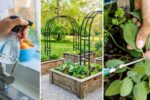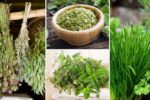Join on WhatsApp
Get the latest updates directly on WhatsApp – motivation, news & more!
Every time we cook, we’re often left with scraps root ends, stems, or tops that usually end up in the trash or compost. But what if those leftovers could be turned into fresh, edible plants again? With a bit of water, light, and patience, many vegetables can be regrown right from your kitchen scraps.
Zero-waste gardening isn’t just a sustainable way to reduce food waste it’s also incredibly satisfying and cost-effective. You don’t need a big garden or fancy tools, just a sunny window, a few containers, and the willingness to experiment. Here are several everyday vegetables you can regrow from kitchen scraps and enjoy all over again.
Green Onions
Green onions are perhaps the easiest vegetable to regrow from scraps. After using the green tops in your cooking, keep the white root end intact. Place it in a small glass with just enough water to cover the roots. Set the glass on a sunny windowsill and watch as new green shoots emerge within days.
You can keep trimming the tops as they grow, and they’ll continue to regenerate. For longer-term growth, transplant the rooted base into soil, and it will thrive for months with minimal care.
Celery
The next time you finish a bunch of celery, don’t toss the base. Instead, place the root end in a shallow bowl of water with the cut side facing up. Keep it in a well-lit area, and change the water every couple of days. Within a week, you’ll see new leaves and small stalks growing from the center.
Once the roots start to form, you can transfer it into soil. Celery grows best with consistent watering and partial sunlight. While it won’t grow back into a full supermarket-sized bunch, you’ll still get plenty of crisp stalks for soups, salads, or snacks.
Lettuce
Lettuce can easily be regrown from the base of a head. Romaine, butterhead, and other loose-leaf varieties work particularly well. After chopping off the leaves, save about two inches of the base. Place it in a shallow dish of water and set it in a sunny spot.
Within a few days, new leaves will begin to sprout. Once roots appear and the plant starts to grow upward, you can transplant it into soil for better development. While you may not regrow a full-sized head, you’ll get a fresh supply of tender leaves for sandwiches or salads.
Carrot Tops
Although you can’t regrow the edible root of a carrot from scraps, you can regrow the green tops, which are surprisingly useful. Save the tops of carrots about an inch of the upper part and place them cut side down in a shallow dish of water.
In a few days, you’ll notice delicate green shoots emerging. Carrot greens have a parsley-like flavor and can be used in pesto, soups, or as a garnish. For a decorative touch, you can also let them grow as a pretty indoor plant.
Garlic
Garlic cloves that have started to sprout can be planted instead of tossed. Simply take a clove with a green shoot emerging and plant it in a pot of soil, pointy side up. Keep the soil moist and place the pot in a sunny area.
The sprout will grow into garlic greens, which have a milder flavor than garlic bulbs and are great for stir-fries, omelets, or topping baked potatoes. If you’re patient, and conditions are right, the plant may eventually form a new garlic bulb underground, though that process can take several months.
Leeks
Leeks, like green onions, can be regrown from the root end. After using the upper portion, leave about two inches of the base intact. Place it root-side down in a glass of water and set it in a sunny window.
You’ll begin to see new green growth within a few days. Change the water regularly, and once roots develop, you can move the leek to soil. While it might not grow to its full grocery-store size, you’ll still get flavorful greens perfect for soups and sautés.
Potatoes
Sprouted potatoes, often considered food waste, can be planted to grow a whole new crop. Cut the potato into chunks, making sure each piece has at least one eye or sprout. Let the cut pieces dry for a day or two to prevent rotting, then plant them in soil with the eyes facing up.
Potatoes need space and consistent moisture, so use a deep container or garden bed. In a few weeks, the plants will sprout above the surface. With proper care, you’ll eventually be able to harvest your own homegrown potatoes.
Onions
Whole onions that have begun to sprout can be planted and regrown into new bulbs. Peel back any soft outer layers and cut off the top, leaving the root end intact. Place it in soil with the top just above the surface.
Water regularly and make sure the onion gets plenty of sun. Over time, the plant will grow green shoots and eventually form a new bulb. You can harvest the greens in the meantime or wait until the bulb matures fully underground.
Bok Choy
Bok choy is another leafy green that’s easy to regrow. Save the base after trimming off the leaves, and place it in a bowl with a small amount of water. Keep it in a bright location and refresh the water every couple of days.
New leaves will begin growing from the center, and small roots may form at the base. Once it starts to take off, you can plant it in soil to encourage further growth. You may not get a giant bunch, but you’ll still have tender, flavorful greens to harvest.
Fennel
If you enjoy cooking with fennel, save the white bulb base after using the fronds or stalks. Place it root-side down in a shallow dish of water and put it near a window. New green shoots will emerge from the center, and roots will develop after a week or so.
Transplant it into soil once roots appear, and with time, you’ll grow more fronds and possibly even a new bulb if conditions are ideal. Fennel requires full sun and well-drained soil, but it’s well worth the effort for its unique flavor and aroma.
Turning Scraps into Sustainability
Regrowing vegetables from kitchen scraps is more than just a fun project it’s a meaningful step toward reducing food waste and creating a more sustainable lifestyle. Whether you live in a small apartment or have a backyard garden, these methods require minimal space and resources.
Not only does zero-waste gardening give new life to what we often throw away, but it also helps connect us to the food we eat in a more intentional way. Even if your regrown veggies don’t turn into full-size versions, the process itself is rewarding and it just might inspire you to grow even more.
So next time you cook, think twice before tossing those scraps. With a little care and creativity, your kitchen leftovers can become the beginning of your next harvest.




